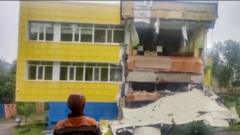The 8.8 magnitude quake rattled near the Kamchatka Peninsula at 11:25 local time on Wednesday (00:25 BST), triggering tsunami warnings that compelled the evacuation of over two million people in regions including parts of Russia, Japan, and the US' Hawaii. Fortunately, initial tsunami predictions did not come to pass. A visitor in Hawaii expressed relief, stating, "The disaster we were expecting did not come."
Although coastal communities in Hawaii rushed to higher ground, reports indicated that only waves of 1.2m hit Oahu and 1.7m struck Maui. Hawaii's Governor Josh Green cautioned against the dangers of tsunamis, reaffirming that they could be lethal. On a positive note, he later confirmed, “So far we have not seen a wave of consequence.” Following the event, the Pacific Tsunami Warning Centre downgraded Hawaii's alert from a warning to an advisory.
In California, waves of up to 1.09m were recorded in Crescent City while San Francisco experienced minor tidal surges. Meanwhile, in Canada, British Columbia issued and subsequently rescinded a tsunami advisory. Russia reported tsunami waves as high as 5m impacting places like Severo-Kurilsk, compelling evacuations but fortunately registering no serious injuries.
Kamchatka's Governor Vladimir Solodov remarked that this earthquake was the most powerful recorded in decades for the area. The incident came with a string of follow-up aftershocks, including a notable tremor measuring 6.9. In Japan, massive evacuation protocols were set in motion as tsunami sirens blared, but like in other regions, tsunami advisories were later adjusted downwards, with no significant damage reported.
Authorities in regions like French Polynesia and the Philippines quickly lifted their tsunami alerts, citing minimal wave activity, while Peru undertook precautionary measures by shuttering its Pacific ports. The quake, located in the Pacific Ring of Fire—a seismically active zone—aligned with historical patterns of significant seismic events. This quake stands among the largest recorded, rivalling other notable earthquakes in the region.
As the dust settles and alert statuses normalize, affected areas slowly return to routine, cautiously optimistic that nature's fury has subsided.
Although coastal communities in Hawaii rushed to higher ground, reports indicated that only waves of 1.2m hit Oahu and 1.7m struck Maui. Hawaii's Governor Josh Green cautioned against the dangers of tsunamis, reaffirming that they could be lethal. On a positive note, he later confirmed, “So far we have not seen a wave of consequence.” Following the event, the Pacific Tsunami Warning Centre downgraded Hawaii's alert from a warning to an advisory.
In California, waves of up to 1.09m were recorded in Crescent City while San Francisco experienced minor tidal surges. Meanwhile, in Canada, British Columbia issued and subsequently rescinded a tsunami advisory. Russia reported tsunami waves as high as 5m impacting places like Severo-Kurilsk, compelling evacuations but fortunately registering no serious injuries.
Kamchatka's Governor Vladimir Solodov remarked that this earthquake was the most powerful recorded in decades for the area. The incident came with a string of follow-up aftershocks, including a notable tremor measuring 6.9. In Japan, massive evacuation protocols were set in motion as tsunami sirens blared, but like in other regions, tsunami advisories were later adjusted downwards, with no significant damage reported.
Authorities in regions like French Polynesia and the Philippines quickly lifted their tsunami alerts, citing minimal wave activity, while Peru undertook precautionary measures by shuttering its Pacific ports. The quake, located in the Pacific Ring of Fire—a seismically active zone—aligned with historical patterns of significant seismic events. This quake stands among the largest recorded, rivalling other notable earthquakes in the region.
As the dust settles and alert statuses normalize, affected areas slowly return to routine, cautiously optimistic that nature's fury has subsided.



















